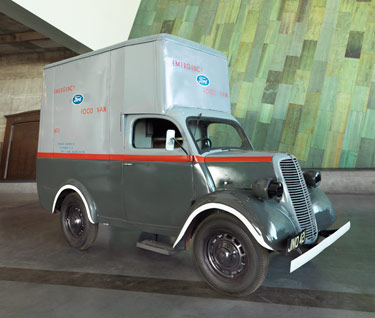Teatime under the bombs
March 26, 2010
Much has been said about the harsh conditions faced by civilian populations during the Second World War – a time when if you were lucky, you’d have the unpopular option of either rutabagas or Jerusalem artichokes on your plate. But when the roads were ruined, buildings destroyed, and the gas was cut, wandering survivors had but one choice: an empty stomach. That is, until the emergency food van rolled in.
Little van, big job
In 1941, Henry and Edsel Ford decided to offer 450 emergency food vans to the British as ‘mobile canteens’ to provide relief to victims of air raids. Their Ford E83W model was revamped to accommodate a basic kitchenette in which volunteers could stand, serve precious tea, and hand out a number of pre-cooked meals.

Their very appearance began to symbolize hope, and the modest Ford vans quickly became a lifeline for many civilians, aid workers, and soldiers. Criss-crossing day and night over stricken areas, the fleet of 450 traveled a total of 1,660,022 kilometres to deliver some 2.5 million meals on the sides of roads and over 5 million meals in schools. Local Ford dealers provided free maintenance on the vehicles which were sometimes roughed up on rough roads.
After the war ended, the Fordson emergency food vans faded into new streetscapes, re-purposed for other adventures. With them disappeared a unique witnessing of history. But since the Canadian War Museum got its hands on one of them, this special piece of the Second World War story can be revealed: the human side of conflict in all its generosity and solidarity.
Friends of the canteen
Fordson Emergency Food Van No. 1 did not report for duty at the Museum in its finest state. Delivered in inclement weather over several years, it didn’t look so hot: rust everywhere, chipped paint, dead motor. Restoring the vehicle to top condition would be a great – and costly – challenge.


So the Friends of the Canadian War Museum (FCWM) stepped in. Not only did they finance the acquisition and restoration of the vehicle, they enthusiastically contributed labour, determination, and time to the project.
The FCWM is a volunteer organization created to provide all manner of support to the Museum. Members do fundraising (their efforts brought in a cool $16 million toward the construction of the new building), undertake research, and volunteer as interpretive guides or at special events. What’s more – as with the mobile canteen – they never hesitate to get their hands dirty to revive vital pieces of our collective history.



The pride of having given so much time and energy to a cause close to their hearts was evident in the faces of these members when the Fordson van was unveiled on February 17. In a workshop at the Museum over two years, they razed, repainted, repaired, and restored the small grey vehicle. The result of their labour now stands on permanent display among the tanks and other armoured vehicles in the LeBreton Gallery as an eloquent testament to humanity’s triumph over adversity.